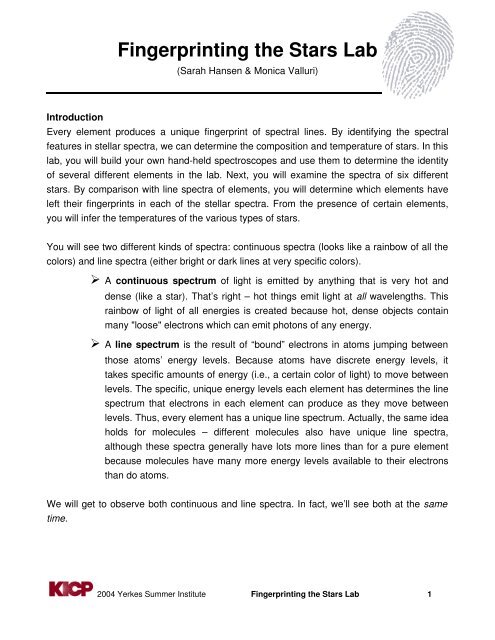Fingerprinting the Stars Lab
Fingerprinting the Stars Lab
Fingerprinting the Stars Lab
Create successful ePaper yourself
Turn your PDF publications into a flip-book with our unique Google optimized e-Paper software.
<strong>Fingerprinting</strong> <strong>the</strong> <strong>Stars</strong> <strong>Lab</strong>(Sarah Hansen & Monica Valluri)IntroductionEvery element produces a unique fingerprint of spectral lines. By identifying <strong>the</strong> spectralfeatures in stellar spectra, we can determine <strong>the</strong> composition and temperature of stars. In thislab, you will build your own handheld spectroscopes and use <strong>the</strong>m to determine <strong>the</strong> identityof several different elements in <strong>the</strong> lab. Next, you will examine <strong>the</strong> spectra of six differentstars. By comparison with line spectra of elements, you will determine which elements haveleft <strong>the</strong>ir fingerprints in each of <strong>the</strong> stellar spectra. From <strong>the</strong> presence of certain elements,you will infer <strong>the</strong> temperatures of <strong>the</strong> various types of stars.You will see two different kinds of spectra: continuous spectra (looks like a rainbow of all <strong>the</strong>colors) and line spectra (ei<strong>the</strong>r bright or dark lines at very specific colors). A continuous spectrum of light is emitted by anything that is very hot anddense (like a star). That’s right – hot things emit light at all wavelengths. Thisrainbow of light of all energies is created because hot, dense objects containmany "loose" electrons which can emit photons of any energy. A line spectrum is <strong>the</strong> result of “bound” electrons in atoms jumping betweenthose atoms’ energy levels. Because atoms have discrete energy levels, ittakes specific amounts of energy (i.e., a certain color of light) to move betweenlevels. The specific, unique energy levels each element has determines <strong>the</strong> linespectrum that electrons in each element can produce as <strong>the</strong>y move betweenlevels. Thus, every element has a unique line spectrum. Actually, <strong>the</strong> same ideaholds for molecules – different molecules also have unique line spectra,although <strong>the</strong>se spectra generally have lots more lines than for a pure elementbecause molecules have many more energy levels available to <strong>the</strong>ir electronsthan do atoms.We will get to observe both continuous and line spectra. In fact, we’ll see both at <strong>the</strong> sametime.2004 Yerkes Summer Institute <strong>Fingerprinting</strong> <strong>the</strong> <strong>Stars</strong> <strong>Lab</strong> 1
Part I: Build Your Own SpectroscopeIn this part of <strong>the</strong> lab, you will cut out and assemble a spectroscope. Whenyou look through <strong>the</strong> spectroscope at a bright light, you will see <strong>the</strong>spectrum of light being emitted spread out inside <strong>the</strong> spectroscope. Thespectroscope has a printed wavelength scale so you can identify particularspectral lines by noting <strong>the</strong> wavelengths where <strong>the</strong> <strong>the</strong>y are located.What You Need:1 Spectroscope Poster1 grating1 pair of scissorsTapeWhat To Do:On one side of <strong>the</strong> poster are step by step directions for making your spectroscope. Follow<strong>the</strong>se directions carefully and you will make a fun and useful tool!Note: It can be interesting to look at <strong>the</strong> spectra produced by <strong>the</strong> lights in <strong>the</strong> room,streetlights, clouds, <strong>the</strong> TV, etc. Feel free to use <strong>the</strong> spectroscope to observe <strong>the</strong> worldaround you, but remember:NEVER LOOK DIRECTLY AT THE SUN!!2004 Yerkes Summer Institute <strong>Fingerprinting</strong> <strong>the</strong> <strong>Stars</strong> <strong>Lab</strong> 2
Part II: Elementary IdentificationNow you will use your spectroscope to identify different elements. In stars,<strong>the</strong>re are spectral lines from many different elements and molecules. Inorder to recognize which lines are parts of <strong>the</strong> patterns of various elements,you will now get a chance to view <strong>the</strong> light emitted by pure samples ofdifferent elements. This way, you can learn each element on its own, before having to sortout several elements all at once in <strong>the</strong> spectrum of a star. Should be easy, right – just lookthrough your spectroscope at a sample of an element….But <strong>the</strong>re’s a catch: it isn’t easy to make an element (or molecular compound) show itsfingerprint of spectral lines. You have to supply enough energy for <strong>the</strong> atom’s electrons tobegin jumping around and showing off <strong>the</strong> line spectrum of <strong>the</strong> element. There are two waysto give <strong>the</strong> electrons enough energy to show a line spectrum:or• Heat <strong>the</strong> substance to a certain temperature range. Only certain temperatureswill do – too hot or too cool and <strong>the</strong> element won’t show itself. <strong>Stars</strong> get to <strong>the</strong> righttemperatures (many 1000’s of degrees) for <strong>the</strong> electrons in atoms and molecules tomake <strong>the</strong>ir signature line spectra.• Send a certain amount of electrical current through <strong>the</strong> substance. Since wecan’t easily heat anything hot enough to produce a line spectrum, in <strong>the</strong> lab we usespecial lamps that send a strong current through a sample of a pure element,triggering it to emit its signature line spectrum.The equipment we use to send a current through a gaseous element is called a dischargelamp. A glass tube filled with gas (called a discharge tube) fits into <strong>the</strong> lamp. When <strong>the</strong> lampis turned on, a current passes through <strong>the</strong> tube, exciting <strong>the</strong> electrons in <strong>the</strong> atoms within,thus causing <strong>the</strong> tube of gas to glow brilliantly. You can <strong>the</strong>n use your spectroscope toobserve <strong>the</strong> line spectrum being emitted by <strong>the</strong> element.2004 Yerkes Summer Institute <strong>Fingerprinting</strong> <strong>the</strong> <strong>Stars</strong> <strong>Lab</strong> 3
Your challenge is to correctly ID eight unknown elements bycomparing <strong>the</strong>ir spectra with a chart showing <strong>the</strong> spectra of manydifferent elements.What You Need:Your spectroscope2 sheets of “Elemental IDs” paperPencil or penWhat To Do:Tape <strong>the</strong> two “Elemental IDs” sheets into consecutive pages in your lab notebook.For each discharge tube:1. Pick a discharge lamp to study, and record <strong>the</strong> number of <strong>the</strong> lamp on a blank IDchart.2. Look through your spectroscope at <strong>the</strong> glowing discharge tube. It may take practice toget <strong>the</strong> spectroscope lined up right so that you can see <strong>the</strong> line spectrum produced by<strong>the</strong> gas in <strong>the</strong> tube. If you are having a lot of difficulty seeing <strong>the</strong> spectrum, ask yourlab instructor for help.3. Sketch what you see in <strong>the</strong> spectrometer on <strong>the</strong> ID chart for that lamp.4. <strong>Lab</strong>el each line with <strong>the</strong> color that it appears, and note in <strong>the</strong> margin which lines areespecially bright and which are weak. Some lines may be quite faint and hard to see.Compare your ID charts to <strong>the</strong> chart of emission lines in <strong>the</strong> classroom. By comparing <strong>the</strong>pattern of lines you observed with <strong>the</strong> classroom chart, you should be able to identify <strong>the</strong>contents of all <strong>the</strong> discharge tubes. <strong>Lab</strong>el each of your ID charts with <strong>the</strong> element you have determined it to be.Congratulations! You now know how to fingerprint <strong>the</strong> elements. Time to put those skills towork…2004 Yerkes Summer Institute <strong>Fingerprinting</strong> <strong>the</strong> <strong>Stars</strong> <strong>Lab</strong> 4
Part III: What’s in <strong>the</strong> <strong>Stars</strong>?Your goal for this part of <strong>the</strong> lab is to determine what elements are showing<strong>the</strong>ir fingerprints in different stars. To do so, you will compare <strong>the</strong> absorptionlines in real stellar spectra to <strong>the</strong> spectra of different elements andcompounds to find which elements/compounds have lines that match thosein <strong>the</strong> stellar spectra.What You Need:1 pack of stellar spectra1 pack of atomic/molecular spectra1 “<strong>Fingerprinting</strong> <strong>the</strong> <strong>Stars</strong>” WorksheetWhat To Do:Tape <strong>the</strong> worksheet into your lab notebook.For each stellar spectrum,1. Record <strong>the</strong> star’s name on <strong>the</strong> worksheet.2. Choose an atomic/molecular spectrum to compare to <strong>the</strong> stellar spectrum.3. Carefully align <strong>the</strong> two spectra you are comparing. Make sure <strong>the</strong> blue end of <strong>the</strong>stellar spectrum aligns with <strong>the</strong> 400.0 nm mark on <strong>the</strong> atomic/molecular spectrum,and that <strong>the</strong> red end of <strong>the</strong> stellar spectrum aligns with <strong>the</strong> 700.0 nm mark.4. Compare <strong>the</strong> two spectra. Are <strong>the</strong>re dark lines in <strong>the</strong> stellar spectrum where <strong>the</strong>re are dark lines in <strong>the</strong>atomic/molecular spectrum? If yes, <strong>the</strong>n that substance is showing itsfingerprint! If no, <strong>the</strong>n ei<strong>the</strong>r that substance is not present in <strong>the</strong> star you arestudying, or <strong>the</strong> star is not <strong>the</strong> right temperature to make thatelement/compound show its spectral lines.5. If <strong>the</strong> atomic/molecular lines are present in <strong>the</strong> stellar spectrum, record thatelement or compound on <strong>the</strong> worksheet in <strong>the</strong> “Substances Present in This Star”column.6. Repeat steps 25 for every atomic/molecular spectrum.2004 Yerkes Summer Institute <strong>Fingerprinting</strong> <strong>the</strong> <strong>Stars</strong> <strong>Lab</strong> 5
Part IV: Stellar TemperaturesNow that you know which elements are showing <strong>the</strong>ir fingerprint spectra ineach star, you can use that information to determine <strong>the</strong> temperature of allthose stars. Recall that different elements have to be heated to differenttemperatures to get <strong>the</strong>m to show <strong>the</strong>ir spectral fingerprints. So when yousee <strong>the</strong> spectrum of an element, you can make a good guess at <strong>the</strong> temperature. Withseveral elements present, you can refine your temperature estimate.What To Do:For each star:1. Using <strong>the</strong> table of temperatures in <strong>the</strong> classroom, find <strong>the</strong> temperature range that isright for producing line spectra of each substance you identified in <strong>the</strong> stellar spectra.? Record <strong>the</strong> appropriate temperature range next to each identified substance in<strong>the</strong> “Substance Temp Range” column.2. Examine <strong>the</strong> temperature ranges you have listed. Do <strong>the</strong>y make sense?Example: Something is wrong if in <strong>the</strong> same star you think you saw an elementalspectrum that is produced only below 5000° and an elemental spectrum that isonly produced above 30,000°. The star cannot be both cooler than 5000° andhotter than 30,000°.If <strong>the</strong> temperatures seem ok, go on to <strong>the</strong> next step. If <strong>the</strong> temperatures you find donot make sense, take ano<strong>the</strong>r look at <strong>the</strong> spectrum and see if you misidentified somespectral lines.3. Determine a temperature range for <strong>the</strong> star that works for all <strong>the</strong> atomic/molecularspectra you see in that star.Example: If you see an atom that produces a line spectrum only in <strong>the</strong> temperaturerange 2000° 3500°, and also see a molecule that produces a line spectrum in <strong>the</strong>temperature range 3000° 4500°, <strong>the</strong>n <strong>the</strong> star must be between and 3000° and3500° to make both substances produce line spectra. Record your estimate of stellar temperature on <strong>the</strong> worksheet.2004 Yerkes Summer Institute <strong>Fingerprinting</strong> <strong>the</strong> <strong>Stars</strong> <strong>Lab</strong> 6
Elemental IDsElement #_______This element is:_____________________Element #_______This element is:_____________________Element #_______This element is:_____________________Element #_______This element is:_____________________2004 Yerkes Summer Institute <strong>Fingerprinting</strong> <strong>the</strong> <strong>Stars</strong> <strong>Lab</strong> 7
<strong>Fingerprinting</strong> <strong>the</strong> <strong>Stars</strong>Star NameSubstances Present in ThisSubstance Temp RangeStellar TemperatureStar1.___________________________________________2.____________________________________________3.____________________________________________1.____________________________________________2.____________________________________________3.____________________________________________1.____________________________________________2.____________________________________________3.____________________________________________1.____________________________________________2.____________________________________________3.____________________________________________1.____________________________________________2.____________________________________________3.____________________________________________1.____________________________________________2.____________________________________________3.____________________________________________2004 Yerkes Summer Institute <strong>Fingerprinting</strong> <strong>the</strong> <strong>Stars</strong> <strong>Lab</strong> 8
















